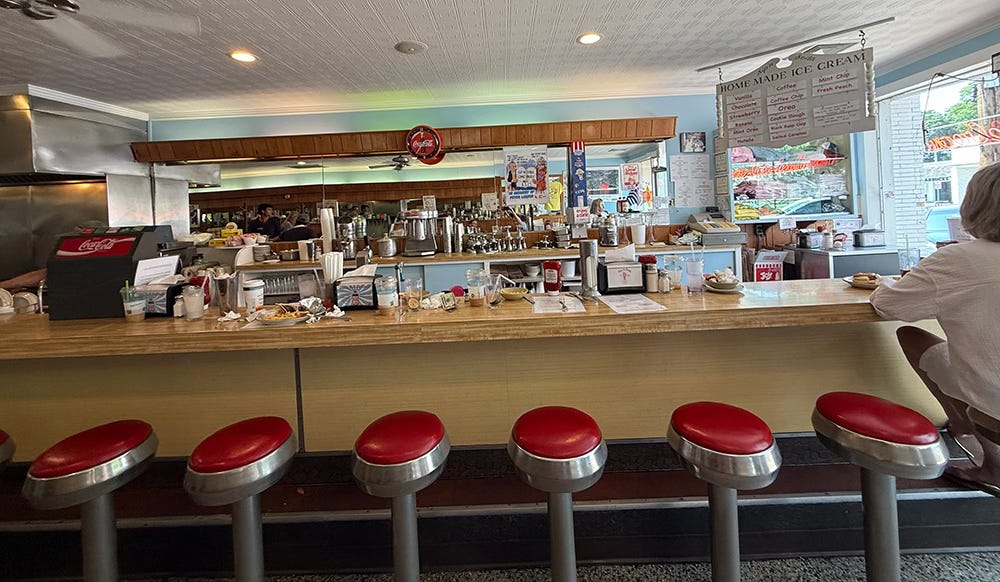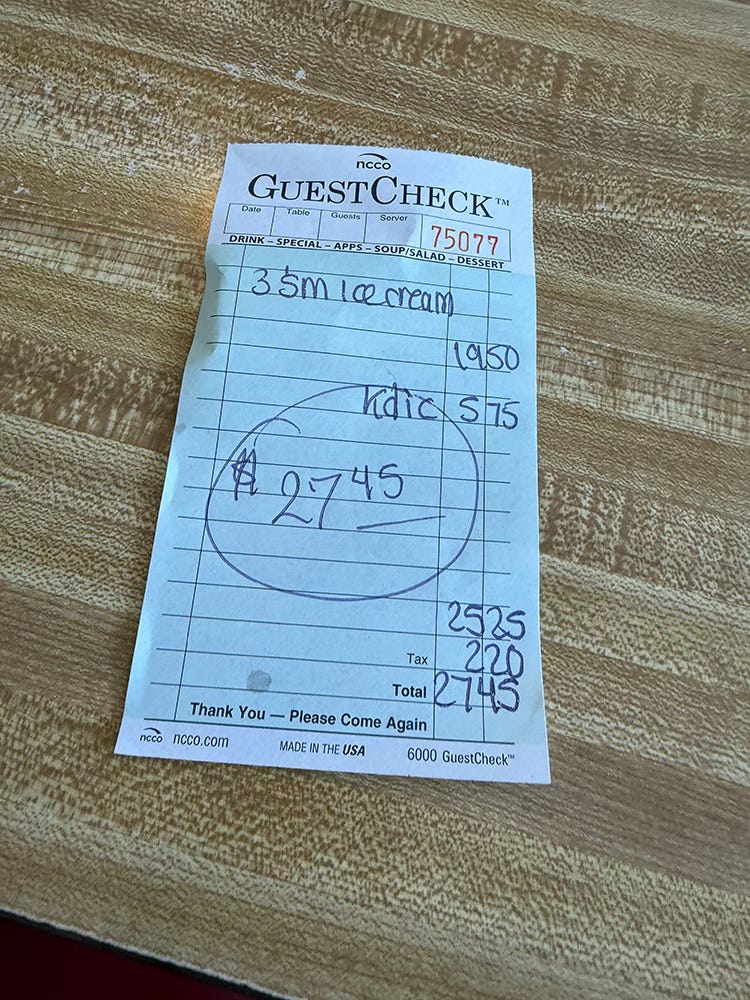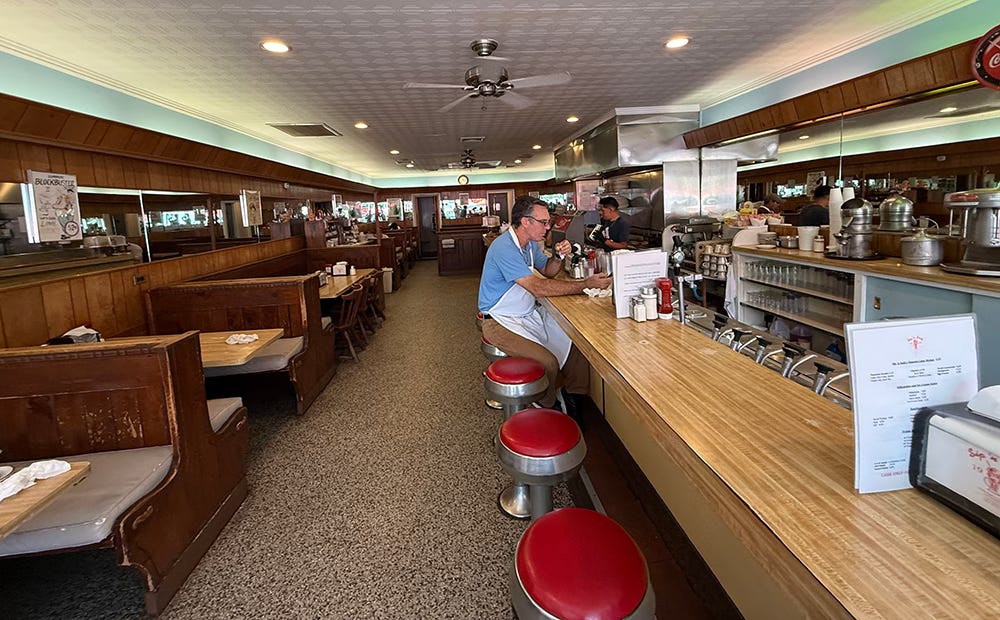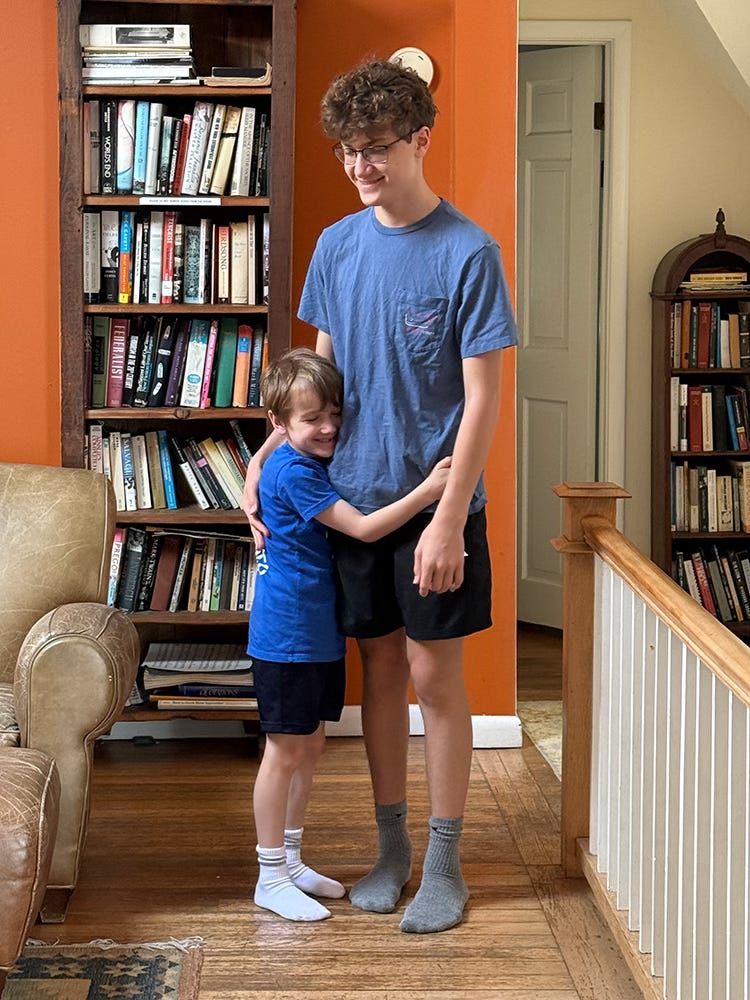What a 1958 diner can teach writers about success
Why you can ignore AI, algorithms, trends, and slop content
If you are a writer hoping to develop a readership, whether that is with your books, essays, newsletters, or other avenues, you may feel pressure to do so in a manner that feels, well, icky.
The internet may have convinced you that to find readers, you need a marketing stack, where you integrate a series of tools that you barely understand to attract readers you will never see. I’m making up all these names, but something like, “Oh, I use Bookinator to promote my BookTok campaign. It combines with my Amazon ads, which I optimize using the Amazon Authorizor program. This, of course, is integrated into my own storefront, where I manage the entire sales process so I earn the highest rate, and then it gets pumped back into my Convertkit automations to retarget my readers with new promotions. I use BookTraits AI, which creates and shares limited time bundles to increase point of sale purchases.”
Or maybe you are seeing more and more compelling case studies around developing an AI-assisted strategy. To upload your entire written archives to AI so it can act as a private tool that can help you do research, provide some outlines, maybe create some content, and get more mileage out of your previously written material. That you can be creating 100x more content via AI.
Do you feel you are out of the loop unless you listen to every podcast and read every forum post to get keen insight into the Amazon and BookTok algorithms and how to hack them?
Or are you creating an influencer campaign based on the latest trends, fueled by the stats/charts/graphs of what seems to be moving when you look at the macro data in publishing?
Regardless of whether you care about these things or not, I imagine you may feel a sense of pressure to. As if you are somehow on the sidelines of publishing, while everyone else utilizes these “innovative” tools above.
Today, I want to discuss an alternative way to approach how you engage readers with your writing. It begins with a story…
The Family That Has Run the Same Luncheonette since 1958
In 1918, the Parash family opened a candy store. Over the years, it moved around to neighboring towns, and then in 1958, they settled in Southampton, New York, and opened a luncheonette calls Sip’n Soda.
My family and I stopped by the other day, and it was like stepping back in time.
The place has a classic setup that I know well. For years, I was a soda jerk at an old-fashioned ice cream parlor first established in the 1920s. Right away, you see the chrome soda fountain, the old wooden booths, stools, etc. I began snapping photos the moment I entered the place.
That’s Mark Parash in the blue shirt with apron, grilling up some burgers. He’s the third generation owner, who began working there in 1992:
Here is a closer look behind the counter:
A pretty impressive crowd for 2:30pm on a Monday:
Of course, they still have a working pay phone in the built-in phone booth in the back:
They still serve ice cream in old-fashioned metal tulip dishes:
They use hand-written guest checks like the ones I did decades ago while working in food service:
They only take cash. And just like diners did for years, they likely count the receipts at the end of the day by — literally — counting the receipts on the pin next to the cash register:
When the crowd cleared out, the owner made himself a sandwich and ate at the bar:
You have likely been to places like this, that feel kitsch and old-fashioned. But there were some big details that made it stand out, and none of them have to do with decor.
At one point, a younger guy comes in, and the owner introduces him to a couple people as his nephew. He serves him a burger and fries, on the house.
As my family and I were walking out, this gentleman held the door for us, and we started talking:
10 minutes later we drove by and saw him getting into his car holding what I assume to be one of Sip’n Soda’s famed Lime Rickeys.
I immediately began thinking of all the lessons this luncheonette had for writers, and how it can inform the way you consider developing your audience, growing your platform, reaching readers, and managing your days. Let’s dig in…
Don’t Scale
I can imagine so many ways that the owner would be encouraged to scale this business. That perhaps he shouldn’t be grilling burgers himself, and instead use his time doing collabs and brand deals.
Years ago I remember reading the book Company of One, by Paul Jarvis. It encouraged one to go against the trend at the time of focusing on scale, scale, scale, and instead consider the value of running a small but sustainable business that you enjoyed.
So often, we become convinced by culture that scaling is the only smart move. That you are somehow missing out if you aren’t constantly creating ways to grow bigger and bigger.
Years ago I went to this barber shop in the town I used to live in. His business was doing well, and he told me that the landlord just offered him the ability to expand in either direction, to a larger space. This was a rare chance that wouldn’t come around again soon, he could expand his space by a little or a lot.
He passed. I was a little surprised by this since his store was in a great location, but he was clearly maxing out how many customers his current setup could serve. When I asked him about this, he talked about not just potential, but risk. That a larger place meant more overhead, more to manage, more maintenance, and so much else. That while there were potential upsides, there were even more downsides.
I haven’t had my haircut there in 20 years, and just looked it up for the first time since then. It’s still there! Had he taken on a larger space, maybe that wouldn’t be the case.
I’ve seen this before in business. Where someone starts out by doing something they love, but then feel the pressure to scale. So they move from doing the work they enjoy, to managing systems, tools, and a staff.
What if instead of scaling, you focused on craft and quality. Where you show up more to the aspects of writing and connecting with readers that you love. To have more moments that provide meaning to your life as a writer.
Challenge Assumptions
Sip’n Soda is located in what I will vaguely call a tourist town. Does it have a wonderful local population? Of course! But Southampton is a destination in the summer. Just around the corner from the luncheonette is a J Crew. Across the street from that is a restaurant that has its own reality TV show on HBO Max.
It’s easy to make assumptions in opposite directions:
In a tourist town like this, you have to cater to big ticket items from known brands.
Or, a place like this luncheonette can only survive in a wealthy tourist town like this.
But I don’t think either is true. Lots of towns have old-fashioned luncheonettes like this one, and one thing that I think makes it vibrant is to be a place of community that people want to experience. Do they initially go there to get a meal? Yep. But I imagine they keep coming back for how it connects them to others and makes them feel a part of moments that matter.
On paper, I can imagine thousands of business ideas that could wring more profit out of that square footage. Or that the owner has had countless people say to him over the years, “Ever think of adding _______ to the space?” Or, “This new generation I’m seeing visit our town, I don’t think they are going to go for the Lime Rickeys. Maybe you do a refresh to the place?”
But you get to choose what you create, how you share it, and the experience that creates. In the process, it may feel uncomfortable to challenge assumptions that are held by those around you. Consider ways you can honor your unique creative voice in this process, even if those around you don’t fully understand it yet.
Show Up
It was fascinating to see Mark in the kitchen cooking up food for customers. So often, owners and managers become distant from the primary work that their business sells. But here he is, apron on, flipping burgers.
I can’t tell you how many writers I have spoken with who tell me they don’t read within the genre/topic they write. They haven’t read other memoirs, don’t read other novels that would be shelved near theirs, and haven’t read other nonfiction books on the same topics as theirs.
Of course, read what you like. And I 100% understand that there are times you don’t want to be influenced by work similar to that which you are writing.
Why I bring this up is that writers will sometimes express frustration about how their book doesn’t fit into the marketplace, when they don’t have any real literacy of the marketplace. They desperately want success, but can’t figure out where in a bookstore their book will be shelved. They’ve never heard of the books it will sit next to, they haven’t looked at bestseller lists for their genre, and have no idea what a typical book description includes.
Can you still succeed as a writer this way? Of course. But, if you are serious about succeeding in today’s marketplace, and feel distant from it, then simply show up within it. Look around, spend some time talking with librarians and booksellers, read a bit, and maybe talk to other writers who have been down the path you are on.
Focus on Moments, Experiences, and Human Connection
In the brief time I was at Sip’n Soda, it was fascinating to hear the conversations the owner had with customers and his staff. After my visit, I looked up the history of the store, and read a quote by Mark where he said he never imagined this is what he would be doing. But what I experienced were the things we hope our days are made of: moments, experiences, and relationships.
The shop wasn’t sentimental due to the decor, but because it focused on things we often say we miss: to walk into a place where people know you, talk to you, and they aren’t all silently looking at their phones.
To me, what this place reminds me of is to honor the connection to other people. In the work I do, I constantly talk about the craft of connection. Sure, you can buy a burger anywhere, just as you can buy a book. But what if you could share in a way that creates moments and memories? Where people feel seen and a part of something?
Forgo Trends and Slop Content
In any business, there can be a pressure to innovate or update. But I think there is something beautiful in craft, in keeping things simple. Of not constantly rebranding and reimagining, but instead getting the basics right, and focusing on the entire human experience.
When I went to pay at Sip’n Soda, I realized it was going to be cash only even before anyone told me. I just sensed it… of course it’s cash only. Is it at times inconvenient? Sure. But also means the store isn’t paying or charging more for credit card fees, and where there is one fewer complicated screen I need to navigate.
This store didn’t have to upgrade their cash register, sign with a credit card processor, or train their staff how to take Apple Pay. Instead, they just focus on the basics: serving food and having a nice conversation.
In what you write and how you share, how can focusing on the basics give you and your readers a better overall experience? Where you aren’t distracted by creating AI generated videos for your book that you don’t love, and no one engages with.
You get to define success as a writer however you like. I just want to encourage you to feel good about whichever path you choose, and to celebrate your unique creative voice.
For my paid subscribers this week, talked about measuring your success of being public as a writer based on conversations and connections, not metrics. See a preview here.
Reminder: if you want to explore working with me, there are two ways I collaborate with writers and creators:
As always, thank you for being here with me.
-Dan
Kids of the Week: We took a trip out to the Hamptons. Appreciating all the small moments with the kids:


















It's like you were reading my mind. I often get asked about using AI in writing, but I love to write so why would I give that up to AI? At the same time, I feel like I should understand AI and what it is being used for.
Dan, I absolutely love this story about Sip 'n Soda! I get the sense that more people are wanting to return to a time of life when things were simpler. Some may call it nostalgia and say we need to "get with the times" about the inevitability of AI takeover, and at the same time, everyone I meet is longing for - starved for - human connection that happens in tangible, meaningful interactions like what you described here!
It really does encourage me with the work I do to welcome everyone in my Substack space so that they receive a personal response from me and to share the stories of ordinary moments that remind us we can still choose to pay attention and engage with life!